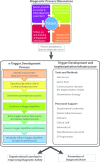Application of electronic trigger tools to identify targets for improving diagnostic safety
- PMID: 30291180
- PMCID: PMC6365920
- DOI: 10.1136/bmjqs-2018-008086
Application of electronic trigger tools to identify targets for improving diagnostic safety
Abstract
Progress in reducing diagnostic errors remains slow partly due to poorly defined methods to identify errors, high-risk situations, and adverse events. Electronic trigger (e-trigger) tools, which mine vast amounts of patient data to identify signals indicative of a likely error or adverse event, offer a promising method to efficiently identify errors. The increasing amounts of longitudinal electronic data and maturing data warehousing techniques and infrastructure offer an unprecedented opportunity to implement new types of e-trigger tools that use algorithms to identify risks and events related to the diagnostic process. We present a knowledge discovery framework, the Safer Dx Trigger Tools Framework, that enables health systems to develop and implement e-trigger tools to identify and measure diagnostic errors using comprehensive electronic health record (EHR) data. Safer Dx e-trigger tools detect potential diagnostic events, allowing health systems to monitor event rates, study contributory factors and identify targets for improving diagnostic safety. In addition to promoting organisational learning, some e-triggers can monitor data prospectively and help identify patients at high-risk for a future adverse event, enabling clinicians, patients or safety personnel to take preventive actions proactively. Successful application of electronic algorithms requires health systems to invest in clinical informaticists, information technology professionals, patient safety professionals and clinicians, all of who work closely together to overcome development and implementation challenges. We outline key future research, including advances in natural language processing and machine learning, needed to improve effectiveness of e-triggers. Integrating diagnostic safety e-triggers in institutional patient safety strategies can accelerate progress in reducing preventable harm from diagnostic errors.
Keywords: diagnostic delays; diagnostic errors; electronic health records; health information technology; medical informatics; patient safety; triggers.
© Author(s) (or their employer(s)) 2019. Re-use permitted under CC BY-NC. No commercial re-use. See rights and permissions. Published by BMJ.
Conflict of interest statement
Competing interests: None declared.
Figures
References
-
- Kohn LT, Corrigan JM, Donaldson MS, Committee on quality of health Care in America, Institute of Medicine. To Err is human: building a safer health system. Washington, DC: The National Academies Press, 2000. - PubMed
-
- Improving diagnostic quality and Safety. Washington, DC: National Quality Forum, 2017.
Publication types
MeSH terms
Grants and funding
LinkOut - more resources
Full Text Sources
Medical

